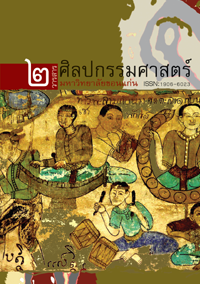การแปรทำนองของเพลงประเภทดำเนินทำนองในรายวิชาทักษะดนตรีเฉพาะทางกลุ่มเครื่องสาย
Main Article Content
Abstract
The objectives of this study are twofold. First, it investigates the process of making variations of three stringed Thai instruments, namely, Saw Daung, Saw-U, and Jakhay from the Dam Nern Tam Nong repertoire designated in the 2003 Bachelorûs degree curriculum at Thaksin Uniersity. Secondly, this research aims to analyze the principal form of the Dam Nern Tam Nong repertoire, which is chosen to be the subject of this study. The musical analysis includes three major topics: (1) musical form or structural pattern, (2) rhythm, and (3) pitches and register.
The research findings show that the Dam Nern Tam Nong repertoire can be characteristically divided into two groups: (1) variable melodies, and (2) fixed melodies. Variable melodies are the compositions with melodic patterns that have leaps and melodic directions for musicians to make variations. Fixed melodies constitute patterns and styles that leave no room for musicians to create and individualize phrase units. Both variable melodies and fixed melodies require the process of making variation in order to stylize the melodies and make it suitable to each instrumentûs tonal timber and register. In addition, the process of making variation have other factors to be taken into consideration: pitches, penta-centric system, repetition of unit phrases, and aesthetics.
The repertoire includes Phleng Payasok sam chan, Pleng Kak Mon sam chan, and Pleng Khmer Yai sam chan. The musical analysis reveals that the form of phleng payasok is a single-section form while the other two compositions involve the repeated-cadence form. All three compositions are in third variation and they are outlined by the ching strokes, which alternate open or undamped sounds and closed or damped sounds. The studies repertoire is entirely governed by the probkai drum pattern. In terms of pitches and register, the three compositions are in the phiang awe bon, phiang awe lang, and chawa pentra-centric system. The nok and khlang modal systems are used in phleng payasok and phleng khak mon.
It is worth nothing that the future study should pay close attention to the process of making variation for the pipat instruments and vocal lines. Such studies on the subject would make great contribution to the development of Thai music research at large.Article Details
Content and information in articles published in the Journal of Fine and Applied Arts of Khon Kaen University is regarded as the opinion and sole responsibility of the author(s) directly; therefore, editors are not obliged to agree to or share any responsibility with regard to the content and information that appears within these articles.
All articles, information, content, image, etc. that have been published in the Journal of Fine and Applied Arts of Khon Kaen University is the copyright of the Journal of Fine and Appllied Arts of Khon Kaen University. Any person or organization who wishes to distribute all or parts of the articles for further dissemination or other usage must first receive permission from the Journal of Fine and Applied Arts of Khon Kaen University before proceeding to do so.


